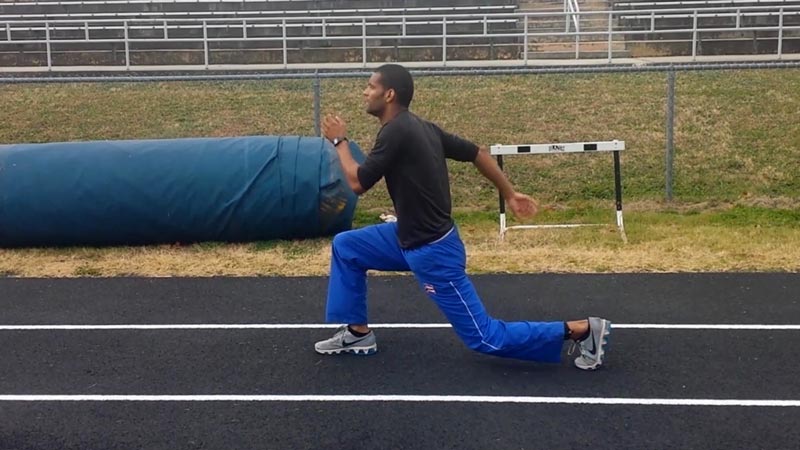English | Español | 日本語 | 中国语文

By Carl Valle
I rarely share workouts because so much is lost online. Without details, the reader is left scratching their heads wondering what to do on Monday. Conversely, articles that show workouts that are popular often discourage thinking and list recipes rather than teaching how to cook. As a compromise, I have listed what I think are universally great and added contextual details that enable athletes and coaches to benefit immediately and over time. My top workouts are the most useful for my situation, and some coaches may feel they have better options. The goal of this article is to make people think about why they are implementing plyometrics in their program and provide a wide variety of options outside the typical box jumps and hurdle jumps.
How I Evaluated the Routines and Exercises
As discussed in a previous article, plyometrics can do more than just increase elastic energy utilization; they can also help with teaching skills and reducing injuries. I chose the routines because I have used them for years or used concepts from the workouts and found them to work at each level of athlete development. I also removed popular options that are well known because rehashing what is widely available is not worth revisiting. Overall I had several considerations that I weighed before adding into my top six, and they are:
- Can a wide variety of athletes use the routines outside of elite track and field jumpers? I still work with athletes outside of sprinters, so I am very much aware of the needs of a professional soccer player and a long jumper getting ready for world championships.
- Does the routine have a unique benefit that may not be easily replicated with different options?
- Is the exercise safe and worth the risk-to-return benefit? Some exercises are very effective but come with too many prerequisites that most athletes will not benefit. Those exercises like hurdle hops and depth jumps for most purposes can’t be the foundation when most athletes need rudimentary exposure today.
- Finally, I included exercises that are a balance between vertical and horizontal displacement, and included exercises that incorporated single and double leg actions. Also, most of the routines don’t include equipment beyond boxes and hurdles, common tools for jump training.
As for sets and reps I left that vague enough to be tailored to the needs of the program. Some training situations will have fewer recovery options, such as programs that are affected by cold climates and have little soft surfaces from which to recover. Also, I don’t like exact recipes since most coaches and athletes will plug routines to programs that may be completely different than my own or the original influence. We all are likely using workouts from someone else as a mentor, but the differences in the other parts of training should influence how we administer the training of specific routines. Just plugging in a workout without blending the nuances is risky, and rejection to the stimulus can increase injuries and have poor transfer.

Traditional GPP Jump Series
When most coaches hear GPP they see a license to include mega volumes, and that leads to junk repetitions. Sure, work capacity is important, but with power activities technique and precise loading is important. A popular and effective series is jumps in place, meaning the athlete is doing a lot of jumping up and down without equipment. The reason I use a series instead of a circuit is because most equate the term circuit with fatigue or conditioning, and that leads to tendon pathologies from which some athletes never recover. I love to include split jumps (scissors), tuck jumps, and rocket/star jumps. All three movements are bilateral, and this is an important lesson on long-term development. First, the use of two legs reduce the wear and tear because stabilization of hopping quickly fatigue stabilizers early in the season. Volume is not everything, but capacity during GPP is still important. Second, running is usually part of conditioning and specificity is overrated when most athletes are prone to overuse syndromes from long competition schedules. Single-leg options must be done sparingly, and when appropriate, done with care.
- Split Jumps 10-16 reps (8 per leg)
- Star Jumps 8-10 reps
- Tuck Jumps 10-16 reps
- Backboard Taps 10-12 reps
At first glance, this looks typical, especially if your coach is coming from the USATF School. The devil is in the details, and the key is the subtle micro adjustments the coach places in the rest periods, volumes, and teaching. Split jumps are about switching legs and getting into the right positions, and the focus is not maximal but coordination. Second, star jumps or rocket jumps are about starting in a ball or collapsed position and expanding into a large amplitude with outstretched arms while in the air before returning to the original position. This is a great exercise to get a real range of motion work for injury reduction needs. Tuck jumps are great for hip flexor strength and reinforcing rapid contraction times. None of this will create the next Vince Carter, but doing 2-3 rounds will create a durable athlete with a solid positional background with joint loading strategies.
Video 1: Two Time Olympian and National record holder Hector Cotto from Sprint Hurdles is doing two common variations of scissor jumps, the first version double swing, and the second more split arm style.

Power Toss Progression
Medicine ball throws are included because elastic energy doesn’t need to be purely jump based to have value. The use of medicine ball throws in different forms is common internationally, but most of the time it’s done because of history instead of a clear rationale. I have a vanilla series that I have done for years that simply is a great general tool to emphasize “contraction clarity” with athletes. The series is three types of throws behind the back or above the head and is a great transition for those that have no experience with Olympic style lifts. The progression of body (jumping) to throwing (with implement) to pulling (snatch and clean) is my bag of tricks to train the athlete while secretly teaching fundamentals of advanced lifting. Save the broomstick teaching for Harry Potter fans and train hard while sneaking in the skills for down the road.
Static Throws – Like a squat jump, throws from a squatting position are great to teach concentric explosions without elastic energy. This is a great way to teach discipline in the blocks without doing starts and is a great way to see who has solid lifting backgrounds and who is getting away with being a good athlete.
Dynamic Throws – Similar to a countermovement jump, going from a standing position down and up with a toss is a great way to see output with some elastic contribution. The elastic energy is not a huge difference, say 5-20% tops, but it’s a great way to get some work in when joints are beat up. Doing power tosses on recovery days are not for everyone, but some athletes find it a great way to wake up the body without creating a lot of eccentric stress.
Reactive Throws – This is the most elastic of throws, when a pre-jump is included to increase the eccentric demand, so more elastic energy is used. Coaches should see the best outputs of power with this option, and if not, they need to look at the eccentric demands of their program and make sure they are providing a clear path to reactive power.
One can do a lot of volume with the throws, but reps of 6-12 are enough to ensure adequate volume if enough sets are included. You can do groups of the same exercise or repeat the above progression over and over depending on one’s training philosophy.
Video 2: Hector Cotto is doing reactive throws and showing great form in this clip. If I had the Ballistic Ball from A2P, I would have been able to see the outputs in clear detail and could have seen precisely how development was going.

Stiffness Hopping and Side Hopping
A mainstay with any jumping athlete is likely to be lateral and medial hops for injury reduction. I find it to be one of my top exercises and spoke about it earlier, but only surveyed the training routine briefly. One of the primary reasons I like stiffness work is injury prevention and development of the muscles and neuromuscular coordination below the knee. The limits to proprioception are not so much balance, but how fast and how strong muscles can be activated. Hopping in one place without the use of the Optojump system (Screening) can be done with athletes doing single leg hops for maximal effort up and down on the track using hurdle markings. I love technology, but budgeting and time constraints make it hard for me to justify a unit outside of a private facility or large college. Athletes will drift (move away) front/back and left/right based on muscle recruitment patterns and joint dysfunctions, and the use of Optojump here is very helpful if you have the budget. Also, power between left and right legs can be tested with a contact mat if one has the budget. The goal is to train and test concurrently and hopping in place is a great starting point.
After an athlete is competent and has symmetry, I like adding up and down hopping from a lifting platform or similar for slightly more demand. After a few weeks of sprinkled vertical hops with slight lateral displacement, I then add hopping to the side (medial and lateral) for 3-4 sets of 8-12 contacts. Some rotational jumps I have added with team sport athletes, but solid ability to handle hops is essential before adding complex landing scenarios.
Video 3: The clip above shows the stiffness hops being done as a way to strengthen the lower leg after training sessions as part of the “cool down”. I prefer to do training units instead of an unstructured warm-down as athletes seem to do lazy stretches and socialize, thus ruining training time. Light stiffness work is a great way to transition from very high intensity work to something lighter and easier.

Low Box Hops and Bounds
I was not a believer in low box work and never got the purpose of why so many coaches swore by the inclusion of the exercise. Clearly one can jump or bound off low boxes but I prefer to hop before progressing to something far more complicated and difficult to calibrate in set-ups. One of the common requests I get in email is what my conjecture is on the mechanism that creates improvement in performance, and I have one guess and that is pre-tension. Pretension is a combination of muscle recruitment before landing and rapid switching from relaxation to stiffening right before foot contact. The reason I believe in this exercise is that I have done fine wire EMG studies with athletes, and for those not knowing what this means is we stuck needles in their muscles to find the truth. I honestly thought pretension was automatic reflexive, and it is for the most part with elites, but some athletes relax too much and have delayed contraction times or stay too rigid to muscles that need to accept the eccentric response. When an athlete can disassociate contractions and joints locally, more high-threshold motor units can get recruited. I have scoured the research and see very little research with increasing pretension and we are talking milliseconds here. What we do know is some muscle recruitment changes are from adaptations, some are from coordination and skill, and some are from surprises by an artificial apparatus such as low boxes.
To summarize the theory, the low box may increase specific RFD (rate force development) to the altered temporal (timing) of the recovery period of the hop or bound and demands a higher recruitment from the athlete. Years ago I felt that this was a parlor trick and was just a way to increase arousal or demand on the athlete but from the video and testing it was accelerating the abilities to create pretension through cognitive and passive neuromuscular adaptations. Do improvements come from adding variety? Maybe. The contractions are different and could yield changes beyond just doing straight hops without the box. The science of pre-tension or muscle activity anticipating an early contraction is scant, to say the least, but this is a good option for challenging athletes. Repetitions of 8-15 contacts per leg and sets of 3-5 are realistic here.
Video 4: Hops onto low boxes can be done with different spacing and sequences, along with different rationales. I like using the low box to help with striking and increasing the relaxation to pre-tension rates and this can be tested with Myotest and Darfish. Randy Huntington was the first to show some great fusion, and Scott Damman pioneered a lot of the use of wearable technology for jumping.

Zigzags, Heidens, or Diagonal Bounding
Lateral bounding is one of the best ways to reduce injuries, build change of direction ability, and target muscles of the hip. Naming conventions can create confusion, but understanding the history and terminology helps coaches appreciate the exercise. Bounding as explained in my earlier articles is alternating between legs. Heidens is named after the great skating hero Eric Heiden. Knowing a little history is important for technique mastery. “Why,” you ask? Most of the lateral skating jumps include a free leg that fishtails behind the athlete, inviting poor recruitment of the support leg. Good technique is essential in general, but when you are doing anything that has great value with injury reduction, don’t reinforce a pattern that increases rotational motion and a slow recovering free leg.
A good rule of thought is keeping the recovery foot hovering over the ground and ready to step on the grass or training surface. If you see the bottom surface of the foot behind the athlete when viewing posteriorly stop and think how this is helping them prepare for the next step. Instead of having the knee bent and foot behind the athlete, have the foot in front of the body as much as possible and the foot ready to land.
My suggestion is starting from a stork stance to deprogram the common technique error to get the non-support hip into front flexion and the foot surface parallel to the ground. Athletes should practice side to side leaping (bounding) and keeping the recovery or free leg in front before moving on to forward progressing bounds. Also, it’s a good idea to modulate sticking of the landings and depths to help prepare for greater efforts. In addition to continuous bounding, some shuffling back and forth creates more lateral speed to overload the deceleration a bit, but one still needs to leap laterally to challenge the body.
Video 5: The forward progressing lateral bounds create a diagonal effect, and this is one of the rare videos I see a good example of a free leg. If one was to search on YouTube, most of the videos are poorly instructed, and you would be surprised how even some popular experts are not teaching the movement optimally.

The Cometti Complex
I first saw the Werner Gunthor video in 1997 while attending the Building and Rebuilding the Complete Athlete in Tampa. I was tired after lunch from a big meal, and the VHS tape woke me up. Seeing a 285 pound freak of nature was awesome, but it made me realize that training was more than just barbells for development of power. Now there is a renaissance of interest with attention on the work of Cometti and Piasenta but with no understanding of the history and context of the coaches and their science. French Contrast work is an option and not a destination. In my articles on potentiation and other concepts of training, the emphasis is always on what is necessary and not what is possible thanks to Henk Kraaijenhof. Only when one has exhausted the basics and direct options does a coach need to get a little “exotic” with their program.
In the video below (starts at 8:00) Werner does ricochet jumps, followed by hurdle jumps, then immediately into stair jumps. Other examples can be seen on YouTube of combination exercises but this is my absolute favorite. Obviously one can argue that this not necessary as some athletes have done with very simple programs, but it didn’t stop Gunthor from winning three world championships in the shot put. While some people will chant the Bondarchuk tables as gospel, Americans have dominated the shot put, and other countries have succeeded as well.
The takeaway for the videos is the need to keep progressing without adding more load or volume. Creativity is about being resourceful without resorting to risk, and coaches should optimize training with efforts in the pairings that complement and contrast contractions and movement patterns. Other resources for training include Gary Winckler’s work from the USATF Level III school in 2006.
Video 6: The entire Werner Gunthor series is worth watching but forward to the 8-minute mark to see what is possible with larger athletes. I don’t recommend anyone do his routine, but observe the contraction dynamics and flight patterns. The rhythm is rather interesting, and one can say with confidence that training was a big part of his success in being a world champion.
Wrapping Up the Routines
Perhaps none of these routines match your needs or maybe all of them are great additions. The examples are what I have found to work for me, and the final option was used to be provocative and evoke ideas beyond simple groupings. If the list does nothing but stir up a little debate or exchange, the article did its job. Some of the exercises and workout routines are not 100% safe so I strongly recommend taking things slow and seek out a coach or expert if you are an athlete and training on your own. In summary, the routines are what I find useful, and I hope other coaches investigate what they think are their best workouts and explore why.
Please share this article so others may benefit?
[mashshare]

Thank you so much, Carl. Quality.
I love the article however the videos were not playing? ????
Can you resend?